Stories that change your
1. "Harrison Bergeron" by Kurt Vonnegut
First published in 1961, Vonnegut’s satirical story imagines a future in which America’s quest for egalitarianism has resulted in laws preventing anyone from being “better than average.” Our title character is born strong, handsome and intelligent — and in order to make him equal to others, he is given golf-style “handicaps.” He has to wear glasses that make it hard for him to see (and that give him headaches). He has to wear weighted clothes and a rubber mask to counteract his strength and good looks.
The US Declaration of Independence states as a self-evident truth that “all Men are created equal,” but in Vonnegut’s story, that idea is extrapolated to an absurd degree — offering some answers that may be uncomfortable to us.
2. "Story of Your Life" by Ted Chiang
3. "Other People" by Neil Gaiman
4. "In a Grove" by Ryūnosuke Akutagawa
A samurai has been found murdered in a bamboo grove. So opens the best-known work from Japan’s undisputed master of the short story (the country’s leading literary prize is named after him, don’t ya know?). Through three conflicting witness accounts — from a woodcutter, a bounty hunter, and an old woman — the story raises the important question of subjectivity when it comes to how we perceive truth.
Akira Kurosawa’s 1950 film adaptation, Rashomon, has since become a byword for stories told by multiple unreliable narrators — but this is the story that started it all. Now the very device of retelling a story from multiple perspectives has become a trope in its own right, appearing in just about every cop show under the sun.
5. "Gooseberries" by Anton Chekhov
6. "The Swimmer" by John Cheever
Once called “the Chekhov of the suburbs,” John Cheever’s most compelling works deal with middle-class struggles. He was from a generation that grew up during the Great Depression but matured into America’s post-war boom, with its picket fences, Coupe de Villes, and backyard swimming pools. And it’s those very pools that factor into Cheever’s most famous story.
Ned Merrill is a respected member of his society in an affluent neighborhood. One summer’s day, while lounging by his friend’s pool, he spontaneously decides to get home by passing through every single swimming pool between there and his own house. The story quickly grows surreal and dark. But under the strangeness of the conceit is the fraught connection between wealth and happiness in this classic story of suburban ennui.
7. "A Small Good Thing" by Raymond Carver
One of the many fantastic stories in Carver’s Cathedral, “A Small Good Thing” finds a young mother and father in a period of shock when their son is left unconscious and after a hit-and-run. To make matters worse, they keep getting calls in the middle of the night from a shopping mall baker telling them to pick up their son’s birthday cake — a cake that might never be eaten.
While it’s true that a lot of short stories are smarter than they are humane, the final act of “A Small Good Thing” delivers a graceful moment of emotional truth: one that will likely stick with you for a while.

8. "The Second Bakery Attack" by Haruki Murakami
And, while we’re on the subject of bakeries, let’s dip our toe into this story from Murakami’s The Elephant Vanishes, which also has a lot in common with a few other entries in this list. A couple of newlyweds in Tokyo wake up hungry in the middle of the night and decide to break into a bakery — a plan that goes awry as they eventually raid a McDonald’s.
Elements of surreal humor are mixed with discussions of free will vs. determinism in a blend that will delight fans of Murakami’s stranger works. If you grew up with Reading Rainbow, perhaps you will enjoy this reading of the story by LeVar Burton.

9. "An Occurrence at Owl Creek Bridge"by Ambrose Bierce
A plantation owner and supporter of the Confederacy stands on a bridge, awaiting his execution by Union soldiers. Recalling the circumstances that led him to this point, the narrative jumps into stream-of-conscious mode as he makes his daring escape and begins his journey back to his wife and kids.
A 1962 French adaptation of Bierce’s short story was aired in America as an episode of The Twilight Zone, which may give you a hint of what’s to come at the end of the tale.

10. "The Gift of the Magi" by O. Henry
If you’ve reached this point (and have been dutifully reading each story as they appear), then you deserve a nice, uplifting palate cleanser. So many short stories have twist endings that find our characters in awful situations that they had never expected — which is why this classic from O. Henry is such a delight. The premise is simple: it’s Christmas time and a young husband and wife are determined to find the perfect present for each other, despite their meager means.
Named after the author, The O. Henry Award is given each year to short stories of exceptional merit — just one of the many short story contests that have been established to encourage new writers to pursue this medium.


































